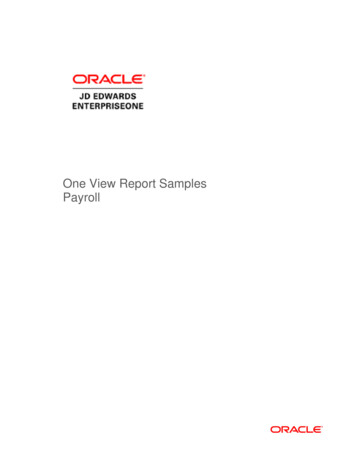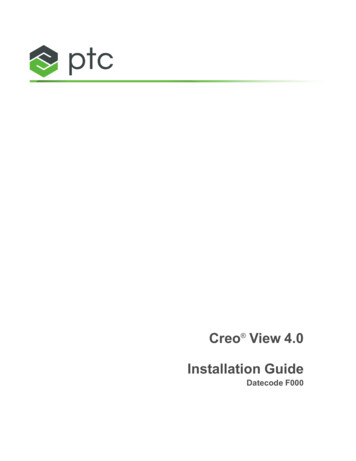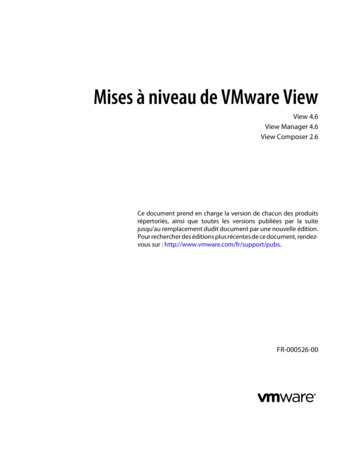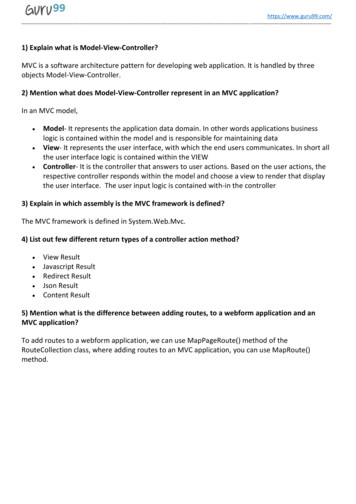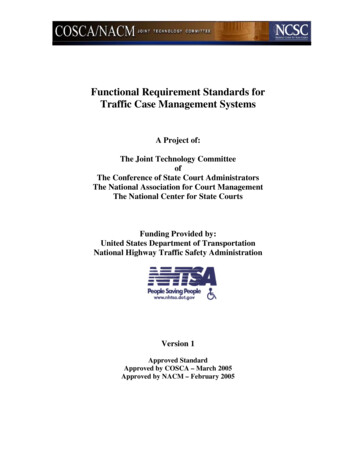
Transcription
WHITEPAPERA CASE STUDY VIEW OF DECEPTIONAND CONCEALMENT TECHNOLOGYIN SECURITY TESTINGAdding Value to Penetration Testing,Red Teaming, and Purple Teaming
OVERVIEWWhether compliance-driven or as part of standard security resiliency testing, security testing is vital to anorganization’s defenses, especially in today’s era of high-profile breaches. Over the past few years, unrelentingreports have highlighted successful security breaches that resulted in compromised personal information, IP theft,financial loss, ransomware attacks, and even attacks on energy and medical organizations, which put humansafety at risk. With the growing sophistication and frequency of attacks, organizations need to evaluate theeffectiveness of their defenses to identify and quickly close gaps that attackers could exploit. A penetration test(pentest), Red Team evaluation, or Purple Team exercise can play an instrumental role in identifying weaknesseswith both security infrastructure and processes.A simulated “real” attack on defenses identifies ways attackers can infiltrate the network based on actualvulnerabilities or inefficiencies. Once in, the testers gather intelligence through reconnaissance activities todetermine the location of assets, which credentials to harvest, and what likely attack paths to exploit. Next, thetesting team checks internal defenses and determines whether the controls are sufficient to prevent them fromaccessing sensitive or critical data or causing damage to critical infrastructure. Often, organizations fail theirsecurity evaluations, putting them at compliance risk and, more concerning, at risk of a breach. Repeatedly, theroot of these failures often lies in the inability to detect in-network attack activity, such as lateral movement,credential theft, privilege escalation, discovery, Active Directory exploitation, and target acquisition.THE ROLE OF DECEPTION AND CONCEALMENT IN SECURITY TESTINGOrganizations typically use deception and concealment technology to detect threats early in the attack cycle, denythem the ability to move while remaining undetected, and misdirect their attacks away from production assets. Itseffectiveness against real threats makes it a valuable resource for a Blue Team when engaging security testers.Deception and concealment technologies offer visibility, misdirection, and early detection of in-network threatssuccessfully evading perimeter defenses. They project decoys that mimic production assets, hide and deny (“cloak)sensitive or critical data and Active Directory (AD) objects from unauthorized access, and seed lures leadingto decoys at the endpoint to obfuscates the attack surface. These measures make it exceptionally difficult forattackers to distinguish between real and fake systems, accounts, and network resources, driving them to makemistakes during lateral movement and reveal themselves early in the attack cycle. The deceptive assets and cloakeddata misdirect attackers from production assets to engage with decoys that record any activity while raising highfidelity alerts.WhitepaperANWP100121www.attivonetworks.com 2021 Attivo Networks. All rights reserved.2
Injecting deception and concealment into the network renders the attack surface exponentially more complicatedfor an attacker to penetrate. The Blue Team can use this to their advantage to prove network resiliency againstnetwork discovery scans, active port discovery, credential theft, Man-in-the-Middle (MitM) attacks, mapped driveaccess, and Active Directory (AD) reconnaissance. Advanced deception and concealment solutions also offer built-inattack analysis to identify lateral attack paths and substantiate attacks. They capture the attackers’ full tactics,techniques, and procedures (TTPs), record Indicators of Compromise (IOCs), and provide forensic artifacts to aid ininvestigation and analysis. Some can intercept Active Directory queries, hide real objects, and feed false informationto redirect the attack into the decoy environment.ATTIVO NETWORKS EMPOWERS BLUE TEAMSThe Attivo Networks ThreatDefend Platform identifies risks, provides least privileges access to data, and detectsthreat lateral movement across endpoints, Active Directory (AD), clouds, and networks. Cloaking hides critical ADobjects, data, and credentials, while misdirection and deception decoys derail attacker lateral movement. Automatedintelligence collection, attack analysis, and third-party integrations accelerate incident response. The platformincludes BOTsink deception servers, the Endpoint Detection Net (EDN) suite, the ADSecure and ADAssessorsolutions for Active Directory protection, and the IDEntitleX solution to protect cloud identities and entitlements.The platform provides the most comprehensive deception and concealment solution for early in-network detectionand accelerated incident response. A key differentiator of the platform’s deception is its authenticity and ability toattract in-network attackers. To test the authenticity and efficacy of how the ThreatDefend solution would respondto an attack, Attivo set up a network with deception and invited skilled and seasoned penetration testers to conductWhitepaperANWP100121www.attivonetworks.com 2021 Attivo Networks. All rights reserved.3
tests in various environments. Their ultimate goal was to capture the flag. Spoiler alert: the security testers in eachscenario failed, commonly after being in the decoy environment for hours. Notably, the Blue team detected and trackedthe security testers for over a week in one case. The efficacy of the ThreatDefend Platform is why a rapidly growingnumber of Blue Teams insist on having the solution deployed during penetration tests.THE THREATDEFEND PLATFORMThe ThreatDefend Platform turns the entire network into a trap, using automation to continually refresh the attacksurface and force the attacker to be right 100% of the time or risk discovery. The solution provides distributed, highinteraction deception decoys and lures that provide early visibility into in-network threats and alerts based on attackeractive observation or action. A unique capability that other deception solutions do not offer is the ability to cloaksensitive or critical local credentials, data, storage, shares, and Active Directory objects to prevent attacker compromise.The example test below highlights how the Attivo Networks Research Lab used a BOTsink appliance, the ThreatStrikeendpoint deception suite, and the EDN suite’s ThreatPath module to validate the platform’s efficacy with an outsideRed Team test.The Attivo BOTsink solution uses authentic, high-interaction decoy technology to lure the “attackers” into engaging,gaining the advantage of early detection and the ability to gather extensive data for attack analysis. The Blue Teamdeployed the BOTsink solution by projecting real Windows and Linux operating system decoys and ran services toappear as production assets, creating attractive targets for the pen-testers. They used the deception platformfor detection across attack phases, focusing on detecting early in the attack cycle. A typical BOTsink appliancedeployment covers various attack surfaces and includes visibility for user networks, data centers, cloud, remoteoffices, and specialized environments (e.g., ICS-SCADA, POS, and IoT). Deployment options include the ability to appearas telecommunications and network infrastructure devices in addition to servers and computers. Additionally, theWhitepaperANWP100121www.attivonetworks.com 2021 Attivo Networks. All rights reserved.4
platform turns every endpoint into a decoy as part of the deception environment with the EDN suite’s Deflect function,which detects and redirects port scans and service discovery to decoys for engagement.The Attivo EDN suite is a modular license that uses customizable and non-intrusive technology to identify targetedattacks on infected endpoints and servers/VMs. It identifies and misinforms attempts to harvest credentials, spread tomapped networked shares, conduct unauthorized AD queries, and scan ports and services on the endpoint. The EDN suitedeploys across devices without impacting the operations of other endpoint security products and servers.In this penetration test, the Blue Team used deceptive credentials as bait to entice the testers to attack decoys insteadof production assets and other network resources. Integrating with the SIEM allowed the platform to automaticallycheck for and report on attempted use of deception credentials throughout the network. Additionally, the Blue Teamdeployed the ADSecure solution to hide real results from unauthorized AD queries while inserting deceptive objectsin their place. The solution gave them early warning when attackers attempted to data-mine AD for objects to use inprivilege escalation activities and target identification.The Blue Team used the EDN suite’sThreatPath module in these tests to provide an attack path vulnerabilityassessment based on likely attack paths that an attacker would traverse through stored credential misuse or policymisconfigurations. They also had the option to use the ADAssessor solution to identify exposures in AD that attackerscould exploit and cloak local credentials with the EDN suite. However, due to time constraints, they did not.The team used a topographical illustration of the attack paths to understand how the “attackers” could laterally moveonce they engaged with their first endpoint system. They also referenced the table views to see 1st, 2nd, and 3rd hopsand identify what attack types could compromise these systems. Clickable drill-downs provided details of weaknessesand IP addresses for endpoints needing isolation or fixing. Although not used in this testing, integrations with workflowsystems like Jira and Service Now are available for creating trouble tickets for remediation within the Dashboard or UI.EX A MP LE 1: RED T E A M T E ST C O ND UCT ED BY A TOP INCIDENT R ESPONSE A NDFOREN SICS CO MPA NYThe EnvironmentThe Attivo Networks Research Lab stood up a network mimicking an enterprise environment consisting of managedproduction Windows systems. They configured the lab network in an AD with member production systems and theThreatDefend platform, using a BOTsink server with decoys deployed in the network consisting of various Windowssystems, with IoT and SCADA decoys for good measure. The Attivo Networks Research Lab deployed the EDN suite forendpoint defenses to each production machine and identified paths between the production systems that an attackercould use to move laterally within the network.WhitepaperANWP100121www.attivonetworks.com 2021 Attivo Networks. All rights reserved.5
The Research Lab gave the Red Team from an independent incident response and forensics company access to oneproduction system as the “initially compromised system,” with a domain user account and a local system accountwith administrative privileges. The team then received instructions to find target data on the network (a Capture theFlag exercise) while staying undetected. The compromised system was part of the AD group called Engineering. Thetarget data was present in the Finance group, where systems hosted confidential information on file servers. TheAttivo Networks Research Lab configured all the systems in the Engineering and Finance groups with the same localadministrator account, and several decoys and desktops had common AD groups.Red Team TestingThe Red Team testers conducted most of their activity over a week. They used various attack tools to conduct ADreconnaissance. With the information they gathered, the testers fingerprinted all the groups, computers, and usersin the AD and targeted each machine individually over the weekend. They used various methods in their attacks,leveraging built-in tools (ping, WMI, PowerShell, etc.) or dropping binaries for remote action (such as PsExec), some ofwhich are detailed below.The Attivo Networks ThreatDefend platform detected the attacker activities on various decoys and production systemsin short order, sometimes within seconds. Below is a sample of the findings from the Research Lab’s analysis.Attack Reports and AnalysisThe Research Lab seeded deceptive credentials on various endpoints and incorporated deception into the production ADenvironment as part of the deployment. As the Red Team gathered data from AD, they found one of the Attivo decoys andtargeted the system using a deceptive LDAP account.The Red Team accessed the decoy system with the deceptive credentials they had harvested from productionsystems and used the credentials to drop an unknown binary onto it.The decoy system captured the SHA1 hash of the binary and the activityperformed on the target decoy. Using this information, the BOTsinkserver’s Malware Analysis Sandbox generated a binary activity report,conducting a VirusTotal lookup using the SHA1 hash to identify thedropped binary as the PsExec tool.PsExec is part of the PsTools suite of the Microsoft Windows Sysinternals Toolkit, and Red Teams often leveraged itin their testing. PsExec is a command-line-based remote administration tool that allows a user to execute processesremotely on other systems. One of the features that make PsExec so powerful is its ability for a remote user toexecute commands on the system with higher-level credentials than the currently logged-on user. Not only can PsExecrun programs on a remote system, but it can also redirect console input and output between systems so that theremote user can utilize interactive tools across the network.WhitepaperANWP100121www.attivonetworks.com 2021 Attivo Networks. All rights reserved.6
The decoy also captured various process activities during the engagement, revealing specific actions and commandsthe Red Team testers executed on the system.The Red Team then conducted network reconnaissance with ping sweeps and port scans toidentify systems they did not find in their AD reconnaissance. Such sweeps can reveal livesystems on the network that are offering services the Red Team could exploit. These scansidentified IoT and SCADA devices on the network, and the Red Team decided to target them.Attackers frequently leverage these systems, which are not part of managed networks, becausethey often lack the security controls present elsewhere. The testers did not realize that theseIoT systems were also decoys posing as a Medical IoT server and a Siemens IoT server.The Red Team then launched Cross-Site Scripting (XSS) attacks to gain accessto the IoT servers. XSS is a common attack vector that injects malicious codeinto a vulnerable web application. IoT controllers that leverage HTML-basedapplications for internal and remote control are often susceptible to XSS if theattacker formats the input correctly. For example, an attacker can inject badHTML into an IoT home web interface, wait for a user to log in, and capture enoughsession information to gain control of the system.WhitepaperANWP100121www.attivonetworks.com 2021 Attivo Networks. All rights reserved.7
One of the ThreatDefend platform’sfeatures is conducting endpoint memoryforensics on a system with the EDNsuite’s ThreatStrike module installed inservice mode. The Research Lab triggeredendpoint forensics on the system theplatform had identified as the sourceof the attacks once the Red Teamhad compromised the first decoy. Theendpoint forensics indicated the RedTeam’s usage of Powershell and otheractivity on the initially compromised endpoint.As is common in many attacks, the Red Team used the credentialsstored on the initially compromised system to access other productionsystems in the network. Users store these credentials for convenience,but attackers steal and reuse them to spread laterally to other productionsystems. The EDN suite’s ThreatPath module captured the Red Team’ssimilar login activity using domain accounts on other production systems.The graph shows the Red Team moving across systems using RDP,identifying the systems they accessed and the credentials they used.The EDN suite captured the Red Team testers moving laterally to two other production systems as they progressedtheir attack. Every time they logged in, the Research Lab tracked the systems they accessed.After a week of testing, the Red Team concluded that they had been discovered and disengaged.Breach Investigation RamificationsIf this had been an actual breach event, the investigators would have acquired a significant amount of detailedinformation to stop the attack and conduct root cause analysis. The ThreatDefend platform successfully detected andtracked attacker activities as they interacted with the network across multiple locations and provided post-mortemforensic evidence recorded during the attack. The fact that the ThreatDefend platform detected the attackers early inthe cycle during their initial scans would have given network defenders timely warning that an unauthorized party hadsuccessfully accessed their internal network. The seasoned Red Team testers disengaged after deciding that the BlueTeam had detected their attack activity in this scenario. Ultimately, deception and concealment proved highly valuablein early detection and attack derailment during the com 2021 Attivo Networks. All rights reserved.8
EX A MP LE 2: EX T E R NAL P E NE T R AT ION T EST AT A HE ALT HCAR E CUSTOMERThe EnvironmentA healthcare organization had arranged for an external Penetration Test to evaluate the resiliency of their informationsecurity infrastructure. They had recently purchased the Attivo Networks ThreatDefend platform and EDN suiteand requested assistance tuning the deception deployment in preparation for the evaluation. The project startedby creating custom Windows XP network decoys from the customer’s golden image, configuring a deceptive ADenvironment, deploying network decoys, customizing various virtual machines, and configuring and deploying deceptivecredential baits and lures. Since the organization used Windows XP widely in its environment, the Windows XP GoldenImage decoy blended seamlessly with the rest of the production systems on the network. The organization also set upthe default web services on the Windows 2008 network decoy.Red Team TestingThe Red Team testers conducted most of their activity over a few days. They used various attack tools to perform ADand network scans and then attempted to access systems through services such as RDP and HTTP.The ThreatDefend platform and EDN suite quickly detected the attacker activities on various decoys and productionsystems early in the Red Team’s attack cycle. Below is a sample of the findings provided by the healthcare organization.Attack Reports and AnalysisThe penetration testing team initiated its test with various scanning activities to identify live systems and serviceson the network. This activity generated alerts on the ThreatDefend platform dashboard as the attackers scanned anddiscovered the network decoys. The organization had immediatevisibility into all pen-tester attack activity and activelyobserved them as they conducted their com 2021 Attivo Networks. All rights reserved.9
As the attacks escalated from internal reconnaissance to accessactivities, the platform recorded all attempts that touched the decoys.The penetration testers focused their access activity on the WindowsXP decoy and the Windows 2008 AD server. They targeted the WindowsXP decoy with various RDP access attempts. They then attacked theWindows 2008 AD server by using production user accounts they hadharvested from the initial access point on the deception AD server. In thisscenario, This attack activity gave the organization visibility into theuser accounts the penetration testers were leveraging to escalatetheir attacks.The penetration testers had also harvested decoy credentials whichthey used to access the Windows XP VM. The platform captured all theirattack activity on the decoy system.The penetration testers found the web service on the Windows 2008Server decoy during their initial reconnaissance activity and targetedthat as well.During the debrief, the organization showed the testing activity theThreatDefend platform had recorded. The organization was impressedwith how the platform had performed during the penetration test. Thevisibility the platform afforded the healthcare organization allowed it topass its penetration test effortlessly and validated the resiliency of itsnetwork defenses.E X A MP LE 3: R E D T E A M T E ST AT A FINANCIAL INST IT U T IONThe EnvironmentA financial services organization had arranged for a Red Team Test to evaluate their information security posture. Theyhad recently engaged Attivo Networks in a Proof of Concept to evaluate the ThreatDefend platform and EDN suite inconjunction with the test. They were also testing the ADSecure solution to protect their production AD environmentfrom unauthorized queries. The POC started by creating and deploying network decoys of various OS types and versions,running an EDN suite ThreatPath module assessment of their production endpoint credential vulnerabilities andmisconfigurations, and configuring and using the EDN suite with the ADSecure m 2021 Attivo Networks. All rights reserved.10
Red Team TestingThe Red Team testers conducted most of their activity over a few days. They used various attack tools to performnetwork and port discovery scans, compromised a few systems, and stole and reused deceptive credentials, andqueried AD for high-value accounts and the AD controller informationThe ThreatDefend platform, leveraging the EDN suite, quickly detected the attacker activities on various decoys andproduction systems early in the Red Team’s attack cycle. The ADSecure solution also detected their AD queries andinserted false information that led them to the decoy environment. Below is a sample of the findings provided by thefinancial services organization.Attack Reports and AnalysisThe financial services organization had conducted an attack surface evaluation with the EDN suite’s ThreatPathmodule to get an idea of the types of credential exposures present in their environment. They used this informationto remediate several credential-based vulnerabilities and identify critical paths between systems and servers.When the Red Team began their testing, the ThreatDefend platform detected their reconnaissance scans immediately.These consisted of ARP scans, TCP SYN port sweeps, TCP Full Connect scans, TCP Half Open scans, and UDPport scans.WhitepaperANWP100121www.attivonetworks.com 2021 Attivo Networks. All rights reserved.11
The Red Team managed to compromise some production systems andstole deceptive credentials. The platform detected their attempts toreuse these credentials on the decoys and some production systemsresulting in login failures that the platform detected.Because the organization had installed the EDN suite with theADSecure module, the Red Team queries returned deceptive AD objectsand information in place of high-value AD objects such as members ofthe domain admins group and AD domain controller information. Usingthe stolen credentials, they logged onto the decoy AD controller.They then attempted to attack the web services on another server, whichwas also a decoy.They eventually logged onto the web services on the decoy server.The decoy also flagged several IDS attempts at another decoy server.The ThreatDefend platform recorded all details of theRed Team’s attacking laptop that they had connectedto the network.WhitepaperANWP100121www.attivonetworks.com 2021 Attivo Networks. All rights reserved.12
The Red Team spent almost three days chasing the decoy AD server information and engaging with the deceptionenvironment before the financial services organization finally instructed them to stop chasing the decoys. In all, theBOTsink appliance generated over 10,000 alerts generated by the Red Team, proving the value of the solution to theorganization as a force multiplier for their security infrastructure.CONCLUSIONAs many organizations test their network resiliency, penetration tests play an increasingly integral role inunderstanding an environment’s vulnerabilities by simulating a real attack. Deception and concealment technologiesprovide early and efficient warning of attacks, whether they originate from malicious internal or external threat actorsor a security tester. The outcome of these tests illustrates how organizations can use deception and concealmenttechnologies to validate network resiliency and prepare for compliance assessment. They can also demonstrate thepower of in-network threat detection and exhibit how they can conceal production credentials and AD objects, usethe gathered attack information to accelerate incident response, and strengthen network defenses. These tests arealso an impactful way to show the instant value of deception and concealment technologies and how easy they are todeploy and operationalize.ABOUT ATTIVO NETWORKS Attivo Networks , the leader in identity detection and response, delivers a superior defense for preventing privilegeescalation and lateral movement threat activity. Customers worldwide rely on the ThreatDefend Platform forunprecedented visibility to risks, attack surface reduction, and attack detection. The portfolio provides patentedinnovative defenses at critical points of attack, including at endpoints, in Active Directory, and cloud environments.Data concealment technology hides critical AD objects, data, and credentials, eliminating attacker theft and misuse,particularly useful in a Zero Trust architecture. Bait and misdirection efficiently steer attackers away from productionassets, and deception decoys obfuscate the attack surface to derail attacks. Forensic data, automated attackanalysis, and automation with third-party integrations serve to speed threat detection and streamline incidentresponse. ThreatDefend capabilities tightly align to the MITRE ATT&CK Framework and deception and denial are nowintegral parts of NIST Special Publications and MITRE Shield active defense strategies. Attivo has 150 awards fortechnology innovation and leadership.www.attivonetworks.com 2021 Attivo Networks. All rights reserved.ANWP100121www.attivonetworks.comFollow us on Twitter @attivonetworksFacebook LinkedIn: AttivoNetworks
Whether compliance-driven or as part of standard security resiliency testing, security testing is vital to an organization's defenses, especially in today's era of high-profile breaches. Over the past few years, unrelenting reports have highlighted successful security breaches that resulted in compromised personal information, IP theft,

